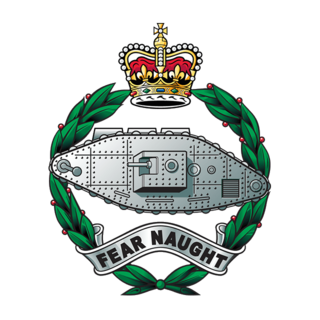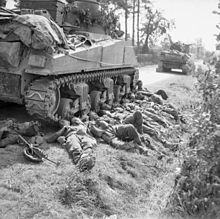
The Royal Armoured Corps is the component of the British Army, that together with the Household Cavalry provides its armour capability, with vehicles such as the Challenger 2 Tank and the Warrior tracked armoured vehicle. It includes most of the Army's armoured regiments, both the Royal Tank Regiment and those converted from old horse cavalry regiments. Today it comprises twelve regiments, eight regular and four reserve. Although the Household Cavalry Regiment provide an armoured regiment, they are not part of the RAC.

The Royal Tank Regiment (RTR) is the oldest tank unit in the world, being formed by the British Army in 1916 during the First World War. Today, it is the armoured regiment of the British Army's 12th Armoured Infantry Brigade. Formerly known as the Tank Corps and the Royal Tank Corps, it is part of the Royal Armoured Corps.

The 6th Royal Tank Regiment was a regiment of the Royal Tank Regiment, of the British Army, until 1959. It originally saw action as 6th Battalion Tank Corps in 1917.
The 16th/5th The Queen's Royal Lancers was a cavalry regiment of the British Army. It was formed by the amalgamation of the 16th The Queen's Lancers and the 5th Royal Irish Lancers in 1922. The reason for the uniquely atypical regimental title was that the 5th had been re-raised in 1858 almost 60 years after being disbanded, and when re-raised took precedence after the 17th Lancers. After service in the Second World War and the Gulf War, the regiment amalgamated with the 17th/21st Lancers to form the Queen's Royal Lancers in 1993.

The 1st Royal Tank Regiment was an armoured regiment of the British Army. It is part of the Royal Tank Regiment, itself part of the Royal Armoured Corps and operationally under 12th Armoured Infantry Brigade.

The 4th Royal Tank Regiment was an armoured regiment of the British Army from its creation in 1917, during World War I, until 1993. It was part of the Royal Tank Regiment, itself part of the Royal Armoured Corps.
5th Royal Tank Regiment was an armoured regiment of the British Army in existence for 52 years, from 1917 until 1969. It was part of the Royal Tank Regiment, itself part of the Royal Armoured Corps. It originally saw action as E Battalion, Tank Corps in 1917.
The Liverpool Welsh, under various guises, was a unit of Britain's Volunteer Force and Territorial Army (TA) associated with the King's Liverpool Regiment. It served as a tank regiment in the Western Desert and Italian Campaigns in the Second World War, as a security force during the Greek Civil War, and as a heavy anti-aircraft artillery regiment postwar.

The 44th Royal Tank Regiment was an armoured regiment of the British Army, which was part of the Royal Tank Regiment, itself part of the Royal Armoured Corps that saw active service in World War II.
The 45th Royal Tank Regiment was an armoured regiment of the British Territorial Army that fought at the Battle of Alamein during World War II and continued to serve during the 1950s.
The 43rd Royal Tank Regiment was an armoured regiment of the British Army's Royal Armoured Corps that tested and demonstrated specialised Armoured Fighting Vehicles during World War II.
49th Royal Tank Regiment, later 49th Armoured Personnel Carrier Regiment and 49th Armoured Carrier Regiment, was a regiment of the British Army's Royal Armoured Corps during World War II that operated specialised armoured fighting vehicles in North West Europe.
The 48th Royal Tank Regiment was an armoured regiment of the British Army during the Second World War. It was part of the Royal Tank Regiment, itself part of the Royal Armoured Corps.

The 23rd Armoured Brigade, originally formed as the 23rd Army Tank Brigade, was an armoured brigade of the British Army that saw service during the Second World War. The brigade was a 2nd Line Territorial Army (TA) formation. It was reorganised and renamed the 23rd Armoured Brigade, when it was assigned to the 8th Armoured Division, although it never operated under command of the division.

The 9th Royal Tank Regiment was an armoured regiment of the British Army active during the Second World War. It was part of the Royal Tank Regiment, itself part of the Royal Armoured Corps. It was reformed in late 1940 as a hostilities-only regiment.

The 144th Regiment Royal Armoured Corps was an armoured regiment of the British Army. Originally raised during World War II as a battalion of the East Lancashire Regiment it was later transferred to the Royal Armoured Corps. It fought in the campaign in North-West Europe, from June 1944 to May 1945.

The 148th Regiment Royal Armoured Corps was an armoured regiment of the British Army's Royal Armoured Corps during World War II. It fought in the invasion of Normandy in 1944.
The Leeds Rifles was a unit of the 19th century Volunteer Force of the British Army that went on to serve under several different guises in the World Wars of the 20th century. In World War I both battalions served as infantry on the Western Front and was later were converted into an anti-aircraft and tank unit, fighting in North Africa, Italy and Burma during World War II.

The 34th Armoured Brigade was an armoured brigade of the British Army that saw active service in the Second World War. It was formed in 1941 as the 34th Army Tank Brigade and subsequently redesignated as the 34th Tank Brigade in February 1945 and became part of the 79th Armoured Division. It was equipped with Churchill tanks and provided close support for assaults by the infantry. During the fighting in North-west Europe from July 1944 to May 1945 the brigade served with both the First Canadian Army and the British Second Army. The brigade was disbanded in early 1946.
The 142nd (Suffolk) Regiment Royal Armoured Corps was an armoured regiment of the British Army's Royal Armoured Corps that was raised in World War II and saw active service. The regiment served in the final stages of the North African Campaign at Tunisia and later served during the Italian Campaign from 1943 until early 1945 when it was disbanded.









